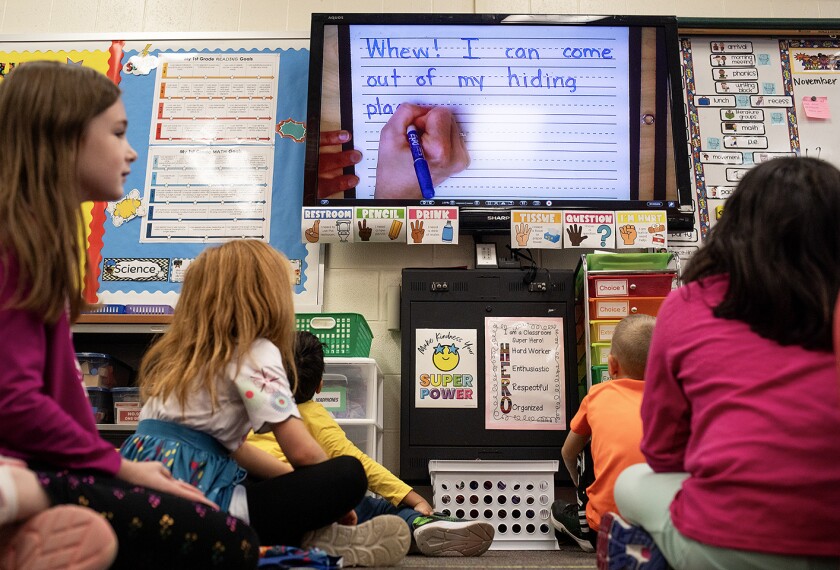Getting all stakeholders to agree on existing K-12 curriculum, let alone newly proposed material, can be tough—as anyone embroiled in ongoing “curriculum wars” can attest. But one subject appears to be growing in demand from parents and policymakers across all political parties: personal finance.
As of December 2023, half of states have committed to ensuring that high school students receive education on personal finance before graduating, up from just eight in 2021. Nearly 90 percent of adults surveyed in a 2022 nationally representative poll said their state should require a semester- or yearlong financial education course to graduate.
Governors on both sides of the political aisle—including Florida Gov. Ron DeSantis, a Republican, and Michigan Democratic Gov. Gretchen Whitmer—have passed legislation in favor of it.
Now comes the hard part: implementation.
In states that passed this legislation only recently, students aren’t likely to see personal finance courses on their schedules for a few years, as states and districts create standards and model lessons. In the interim, advocates and personal finance educators offer advice for making that instruction meaningful.
Start early and make it count
Most states implementing personal finance as a graduation requirement mandate a single stand-alone, semester-long course. Experts advise more.
Personal finance education is a cumulative process, believes John Pelletier, the director of the Center for Financial Literacy at Champlain College and the author of an annual report on the topic. Pelletier encourages schools to teach personal finance in prekindergarten through 8th grade, and particularly in the latter half of high school.
“Students in those grades are poised to enter college, the workforce, or the military, and will quickly face a host of complicated financial decisions,” he writes in the report.
Other advocates agree that the single course requirement should be just the beginning.
“Be careful not to just check the box. Lean into it, figure out how you can optimize it beyond just the requirement,” advised Bill Parker, the director, Tennessee Financial Literacy Commission, within the Tennessee Department of Treasury.
Provide adequate time to develop curriculum
While advocates for personal finance education are eager to see related curriculum implemented in schools, they caution school systems to take the time necessary to develop effective courses.
“Having a long enough horizon to make sure teachers and schools are able to prepare to institute this effectively is important,” Parker said. “Four years is probably a good window.”
Providing a long lead time can help schools hammer out logistical details. Carving out a space in the schedule for a new course takes time. Given that most recent legislation requires personal finance to be a semester-long standalone course, administrators may need to bump or move an existing elective.
Identifying interested educators willing to be trained to teach the course also takes time. Schools that already have implemented personal finance courses typically report recruiting one or more current staff members from departments as seemingly disparate as math and social studies—the main criteria being an interest in the subject.
Parker advised that the focus on delivering meaningful coursework should not end once a class launches.
“Make sure that teachers are wellsupported, and that they have access to quality materials that are routinely updated and remain relevant,” he said.
Access free or subsidized funding for teacher training and curriculum materials
Grants and other resources, many of them free of charge to educators, can support curriculum development and teacher training, say experts. Some states have partnered with the Council for Economic Education to secure grant funds for teacher professional development in financial literacy, which typically run between $200 and $600 per teacher, according to a widely cited 2022 best practices report by Montana State University economics professor Carly Urban.
The report also cites grants to educators for funding financial literacy through the nonprofit Next Gen Personal Finance.
Make it engaging
As with any subject, students are more likely to pay attention and absorb the content if it’s engaging. Online games, such as those created by Next Gen Personal Finance for high school students, can be part of an effective strategy. The topics covered in those games include paying for college, budgeting, and understanding credit. The games are free of charge.
Kerri Herrild, who has taught personal finance to high schoolers in De Pere, Wis. for almost two decades, reports using these resources in her classes. She also shares some of her own personal financial information with students to help them gain an understanding of what budgeting entails. “They see my paycheck, my retirement account, learn about my insurance premiums and related costs, see my credit score,” Herrild said.
She teaches practical content like how to create a budget sheet, and gives students realistic advice they might not otherwise get about financial decisions like how to navigate college student loans. Former students have told her that her lessons made an impact.
“I love running into former students,” Herrild said. “More than one has said to me: “I only have this much in student debt, and that’s because of you, Ms. Herrild.’”






